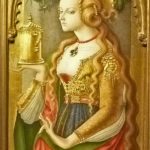If you are planning a trip to Rome, a visit to the Papal Basilica of Santa Maria Maggiore is a must. This grand basilica, which is dedicated to Our Lady, will leave her mark on you: the gold ceiling which stretches far above one’s head, hearkens to a world beyond our reach where the Queen reigns in majesty beside her august Son. Additionally, there is a small chapel housing a relic of Our Lord’s crib which makes tangible the physical reality of our Faith: of God who became man, a small baby, on Christmas morning. St. Ignatius of Loyola prayed his first Mass there on December the 25th, 1538. A Sistine chapel, named for Pope Sixtus V (differs from the Vatican’s Sistine Chapel) houses the Holy Eucharist, and the remains of the great Pope Pius V of Lepanto and Rosary- victory fame. Now incorrupt, the visitor may view his body through a glass paneled tomb. His body is lovingly clothed in papal regalia as it awaits the resurrection of the dead. And, lo, across the church from Pius V is the Borghese Chapel which houses the miraculous icon named Salus Populi Romani, or Our Lady, Health of the Roman People. It was painted by St. Luke, and was brought to Rome in the 6th century. The icon has an illustrious history, with stories of miracles and victories over dangers to the city of Rome, and the Roman Catholic people, see here. It has been crowned and honored by many popes. The Roman Catholic people love it, and hold it in high esteem; which leads me to the topic of today’s post: the 2017 restoration of the Salus Populi Romani.
As with all art work, time takes its toll. This beloved icon was no different. The wood on which it had been painted had begun to deteriorate, and the paint had been touched up over time, resulting in a darkening of the entire icon. All of this indicated a need for a restoration, which took place in 2017. The halos of the Blessed Virgin Mary, and Jesus Christ, were restored to their original gold; Our Lord’s tunic was restored to its original gold; parts of the deteriorating wood were filled in, and repaired; and, more, see here. It is amazing that restorationists can renew a piece of art without harming the original image.
The following is a short video clip of the restoration work in progress, or you may view it here:
A glimpse at this beloved icon reminds me of the mingling halos concept discussed by the English Catholic writer G.K. Chesterton: in the icon, Our Lady sits upright looking at the viewer, but with one movement from her Son, her head would turn to him, and the halos of Jesus and Mary would mingle, indicating the inseparable relationship between the Mother of Christ, the Mother of God, and her Divine Son. G.K. Chesterton wrote:
“You cannot chip away the statue of a mother from all round that of a newborn child. You cannot suspend the new-born child in mid-air; indeed you cannot really have a statue of a newborn child at all. Similarly, you cannot suspend the idea of a newborn child in the void or think of him without thinking of his mother. You cannot visit the child without visiting the mother, you cannot in common human life approach the child except through the mother. If we are to think of Christ in this aspect at all … we must admit, if only as we admit it in an old picture, that those holy heads are too near together for the haloes not to mingle and cross.” ~G.K. Chesterton, from The Everlasting Man
So, as I wrote in February of 2018: understanding the idea of the mingling halos of Jesus Christ and the Blessed Virgin Mary is the beginning of understanding devotion to Jesus through Mary. And: when voices call to split these two apart, look to the Church, (and look to the Salus Populi Romani, added today by SCF) and refuse to listen.
Finally, when on a Roman holiday, do stop by the Basilica di Santa Maria Maggiore, and visit the Salus Romani Populi. The (now) restored mingling halos await you!
May you have a good day.
~SCF
~Image: the restored Salus Populi Romani, source of image here.






